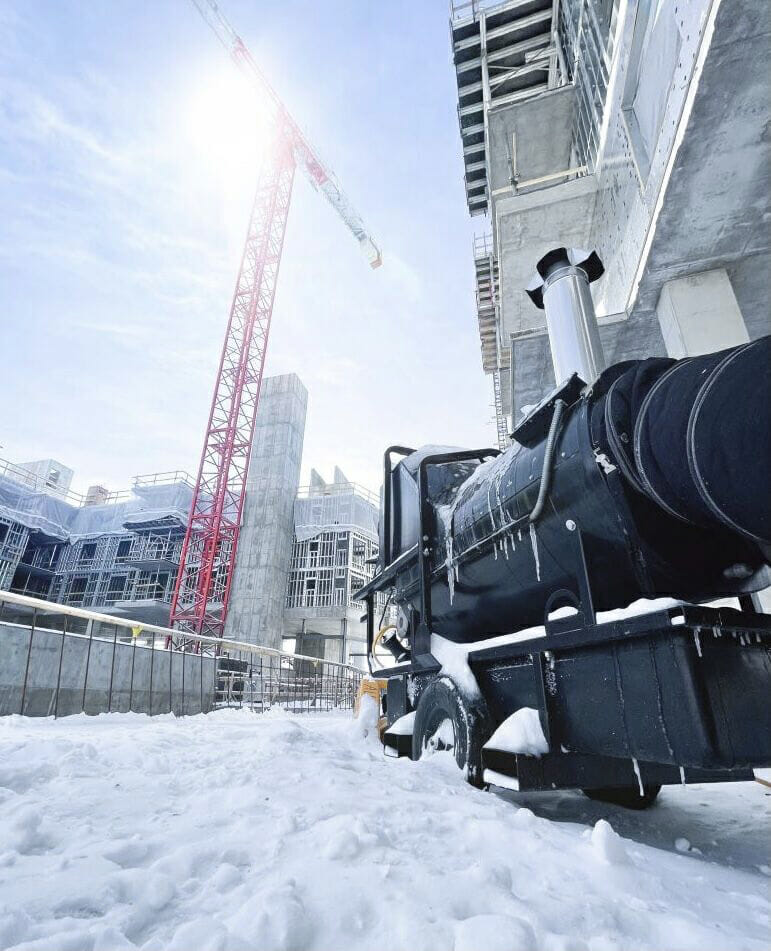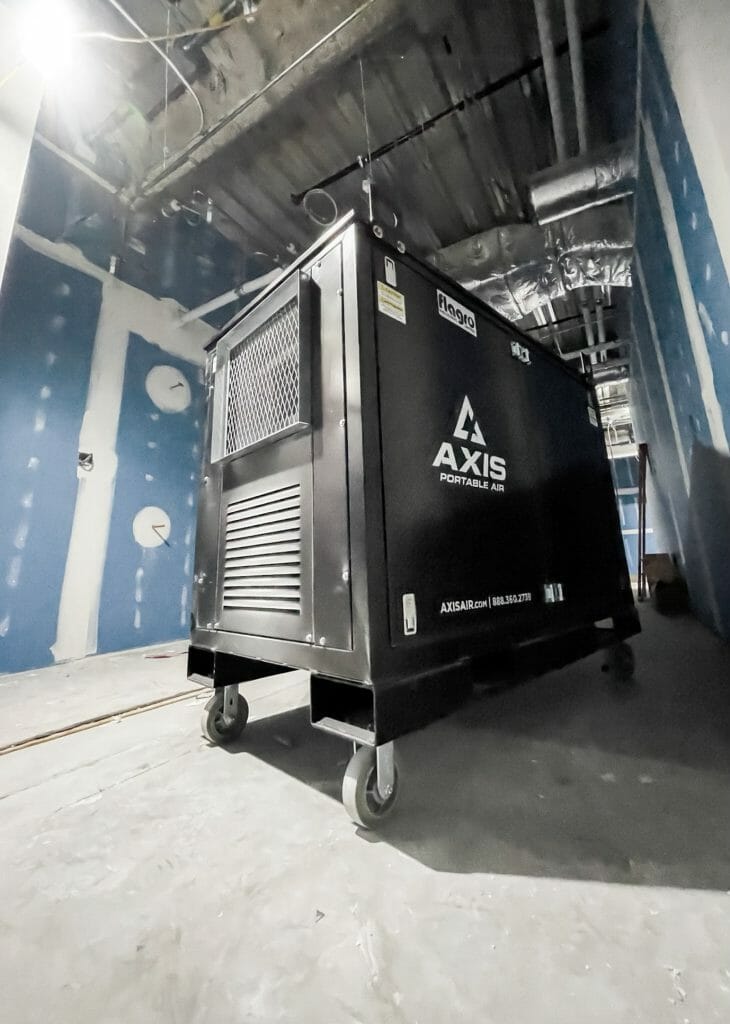When temperatures drop, maintaining warmth on your job site is crucial—not only for comfort but also for staying on schedule and protecting your materials. Cold weather can disrupt work, causing unsafe conditions, delayed timelines, and even damage to construction materials. At Axis Portable Air, we offer a variety of portable heaters to meet your site’s needs and ensure a smooth workflow.
Why Are Job Site Heaters Important?
Portable heaters keep job sites at comfortable temperatures, essential for:
- Staying on schedule: Cold weather can lead to uncomfortable or even unsafe work conditions, slowing down production.
- Protecting materials and processes: Certain construction tasks, like painting or concrete work, require specific temperatures to prevent delays or quality issues.
Your application site requires proper heating. It’s common to find yourself overwhelmed by the choices available. At Axis Portable Air, we carry various types of portable heaters and other equipment for indoor and outdoor projects. These include:
- Direct Fired Heaters
- Indirect Fired Heaters
- Electric Heaters
- Radiant Heaters
- Make-Up Heaters
If you need to purchase a heater for long-term use, or you need to rent short-term/emergency heating to protect employees and equipment, you’re in the right place. This guide explains the differences between heaters, how to determine heater size, and how to choose the right portable heater for your job site.
Types of Job Site Heaters
First, let’s look at what characterizes various heaters, so it’s easier to understand which equipment is right for you.
Direct Fired Portable Heaters
A direct-fired heater provides high-power, forced-air heating using propane or natural gas, similar to a barbecue grill or gas stovetop. It uses an open flame, where air moves over that flame from a fan. After the air is heated, it is either ducted into an area or goes directly into the room with the heater. You can set the thermostat on a direct-fired heater to maintain your desired temperature.
Direct-fired heaters tend to be less expensive and more efficient than indirect-fired heaters, as they can typically produce more heat using smaller equipment. But depending on what type of heat you want, an indirect-fired heater may be a better solution. Also, because direct-fired heaters produce combustion products into the airstream, you’ll need proper ventilation so carbon monoxide and other gases don’t build up in your space.
Indirect Fired Portable Heaters
An indirect fired heater uses a flame inside a heat exchanger and keeps the flame and its emissions separate from the heated air. The air moves over the enclosed heat exchanger and stays separated from the flame, which heats the air and results in 100% clean-burning heat. The byproducts are ducted out via a small chimney stack, similar to an at-home fireplace. These heaters also have a thermostat you can set to your desired temperature.
In addition to clean heat, another advantage of an indirect fired heater is that it can recirculate all of the air, making it an ideal solution for tightly sealed spaces. Direct-fired heaters require outside fresh air to maintain proper combustion if building air is recirculated. But because there’s heat loss through the chimney stack with indirect-fired heaters, they are less efficient than direct-fired heaters.
Electric Portable Heaters
Electric heaters require a power source to heat a space and come in a few different types. Convection forced-air heaters warm the air the heater’s in contact with and circulate the warm air throughout the room to distribute it. These heaters may include a fan to speed up air circulation and heat distribution.
Electric ducted and tented heaters are designed for enclosed areas, like tents and hazardous locations. Electric heaters can be around construction hazards like dust, powder, flammable gas, and vapor.
Another type of electric heater is a ground thaw heater, which can thaw frozen earth, so excavation and foundation work can happen. Ground thaw heaters may also use fuel sources like diesel.
Radiant Portable Heaters
Radiant heaters are electric heaters that deliver heat via thermal radiation, which travels on electromagnetic waves. That means they provide an advantage of providing heat directly to those near the heater, which means your employees can get warm more quickly because all the air temperature in the space isn’t warmed up. The closer your employees are to a radiant heater, the more they’ll feel the heat, and vice-versa.
That’s why radiant heaters provide effective spot heating, especially in outdoor areas. You can use them in places where you need heat in a specific area or in a place that’s too open for all the air to be heated.
Make-Up Air Portable Heaters
Make-up air heaters take in fresh air from outside a building to replace existing air inside a building that can’t be recirculated. In that sense, it “makes up” the air inside that was removed due to process exhaust fans.
Make-up air heaters can improve the indoor air quality of a job site. They help facilitate the removal of air contaminants, similar to a ventilation fan, while providing heat.
How to Determine the Size for your Job Site Heater
Getting the right-size heater will help you produce heat more efficiently and potentially save on overall heating and energy costs. In some cases, you may need multiple heaters to keep your workforce comfortable and various types of heaters in a single space, depending on their location.
Some key questions you’ll need to be aware of to determine the ideal size of heater for your application are:
- The average temperature of location without heat
- Desired heat temperature
- How quickly do you need to raise the temperature
- Type of heater are you looking for
- Fuel sources available
- Where do you plan on placing the heater
- Type of insulation your space has
- Elements in your space (for example, do you have a roof, doors, and windows)
As you can see, one size doesn’t fit all when it comes to heat. That’s why we recommend connecting with the experts at Axis Portable Air, so we can walk through your project with you, look at any drawings/specs, and then provide the best heating options and solutions for your project.
What Types of Job Sites Need Heaters?
Various job sites benefit from portable heating solutions, including:
- Construction sites
- Warehouses
- Tented events or temporary structures
- Manufacturing plants
- Outdoor events
Should You Start Making Heating Plans for Your Job Site?
It’s never too early to have a plan in place when it comes to managing temperatures. When you know you’ll need heat in the winter, we highly recommend engaging Axis Portable Air on your project in August, no later than the beginning of September. Planning gives us time to walk the project, provide budget numbers and reserve your heaters for the winter season.
You may think you’re saving money by waiting to put a heating plan in place. Take it from us; you’re not. By waiting, you could pay more for your heaters when they’re in high demand and risk time delays. At Axis Portable Air, we offer a “seasonal rental” for your heating solution. Seasonal rentals provide heaters from the beginning of the cold season until the end of March, covering you for heat during the coldest months. That’s why it doesn’t hurt to reach out and put a heat plan in place for your project before winter starts.
We understand that emergencies and extreme weather conditions may cause unexpected heating needs, and you can’t always have a plan set in place. We’re here to help. We have a robust heater fleet. We continuously monitor inventory levels throughout the winter, so we’re prepared to meet all client needs. In addition, we track weather conditions nationwide to be ready for extreme weather emergencies.
Need job site heaters? Contact Axis Air
Axis Air carries the highest-quality heater brands on the market today for both rental and purchase. We offer Flagro, Campo and L.B. White brands. We also have small heat pump units from the MovinCool line for indoor retail. So while we’re primarily a rental company, we do offer sales of all the heater equipment product lines we carry, as well.
In addition to our diverse heating equipment offerings, our people distinguish Axis Portable Air from others in the industry. We provide exceptional customer service so we can solve your problems quickly. Year after year, we have more customers reaching out for heating solutions because of the experience and level of service we provided the previous season. We appreciate the opportunity to show customers the exceptional service we provide when heating a project. Ask us about the best heating options for your site.
CLIMATE CONTROL





